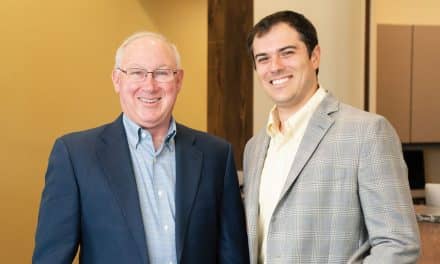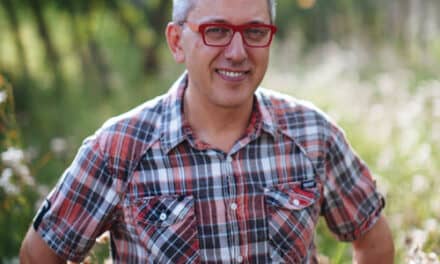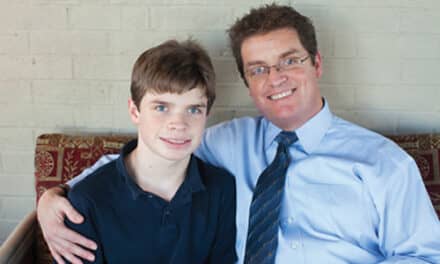Whether it’s enlisting in the National Guard, joining an established practice, or adopting uLab’s aligner platform, Jeremy Manuele, DMD, isn’t afraid to take on new challenges.
By Steven Martinez | Photography by Breann Patty
Jeremy Manuele, DMD, of Hamilton & Manuele Orthodontics in Las Vegas, Nev, wanted to be an orthodontist for as long as he could remember.
In junior high school, he went through a rough time when his parents were going through a divorce, and he moved to a new town. A difficult period for many kids, Manuele says his canines were also starting to come in and they didn’t have enough room.
“They were way out, facially ectopic, and I hated my smile,” says Manuele. “In middle school, you’re probably extra self-conscious about things anyway, at least I was, and my smile just added to that. So, I begged my parents for braces.”
His parents agreed, found an orthodontist, and put him in braces. It turned out to be a formative experience.
Manuele was fascinated by the way they were able to move his teeth into the right position. He didn’t remember any pain or discomfort, he says, only how cool he thought the process was and how great his smile looked in the end.
“My life improved after that and I always associated that with the braces,” says Manuele. “I probably gave it more credit than it deserves. I’m sure there’s a lot of other things in my personal life that naturally improved over time, but it coincided with my time in braces and the two were forever connected in my mind.”
From then on, Manuele knew what he wanted to be. His mother saved a school assignment from 7th grade, where he clearly stated his intention of going to school for about 5 years to become an “oarthadontist,” misspelling the word orthodontist.
“I had no idea what was in store, but my goal had little variance from that along the way,” says Manuele. “There was a time when I looked into optometry and plastic surgery, but I always came back to orthodontics.”
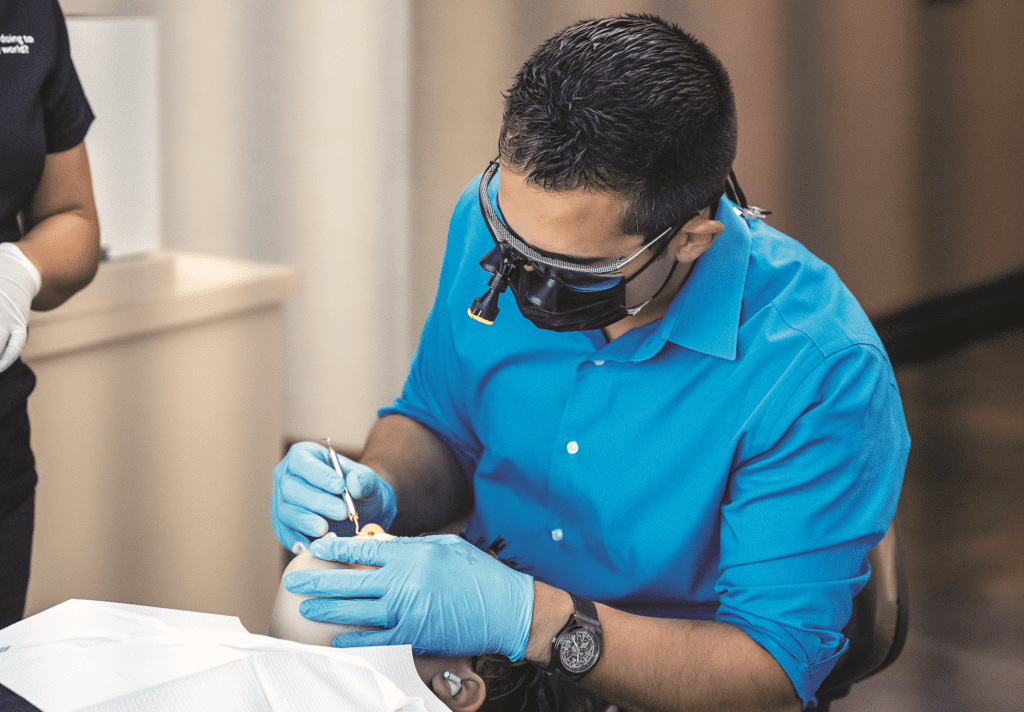
A few years later, Manuele experienced another formative experience when a military recruiter from the Utah Army National Guard came to his high school. The recruiter told students that they would be holding a meeting nearby to talk about joining. His grandfather and stepfather had both served in the Army. Manuele knew that he wanted to serve in the military too.
At the meeting, the recruiter asked Manuele if he wanted to, “shoot some cannons and stuff?”
“That sounds fun. Yeah, let’s do it,” says Manuele. “That’s probably a little bit reflective of who I am. I’m an under-researcher, I jump in and make things work.”
Manuele was only 17, but his parents signed off and in the summer between his junior and senior year of high school, he went to basic training and later after graduating, he went to specialty school to learn his role in operating the M109-A6 Paladin, a tank-like mobile artillery platform, as part of a field artillery unit.
He worked his way up the ranks, becoming a gunner before being deployed for 18 months in 2005-2006 to Ramadi, Iraq, during what would later become known as the Battle of Ramadi—a monthslong period of intense urban warfare to restore control over the city from a growing insurgent threat.
Manuele says his unit spent a third of the time providing artillery fire for the battles in the city. The rest of the time, they were tasked with protecting forward operating bases and patrolling key areas for insurgent activity.
“One thing that I remember was the unity between the people I was with,” says Manuele. “When stuff got scary, we were there together. What stands out most to me is just how strong of a bond you form with your fellow soldiers. Still to this day, some of my best friends are guys that I deployed with.”
In 2004, before his deployment to Iraq, Manuele married, bought a part of the vacuum and sewing machine businesses his father was running, and started college. But between his life and National Guard duties, he only had time enough to finish a semester and a half of college before deploying.
When he returned from Iraq, he dove back into schooling to make up for the 3-year hiatus. With financial help from the GI Bill and scholarships, he finished his undergraduate studies and dental school at the University of Nevada, Las Vegas, where he now teaches orthodontics part-time. He then embarked on a 2-year residency in orthodontics at the Louisiana State University Health Sciences Center.
Six months into his residency Manuele attended an orthodontic meeting where he met Todd Bovenizer, DDS, a lecturer and practitioner in North Carolina. While chatting with Bovenizer, he mentioned where he was from. Bovenizer suggested he look up his friend Cree Hamilton, DDS, MS, if he ever went back to Las Vegas.
Near the end of his residency, Manuele sent a message to Hamilton to see if he was interested in taking on a partner. Hamilton responded, saying that he had people reach out to him every year and he only answered because Manuele mentioned his friend, Bovenizer.
The first time Manuele and Hamilton talked, the call lasted 4 hours and by the end of it, they recognized that they had a connection.
“It was an instant friendship of mutual respect,” says Manuele. “It was one of those connections that we knew wasn’t a coincidence. I was listening to his vision, values, and goals and thinking, man, this is really similar to what I envisioned, and I just never found it in a practice before then.”
Manuele shadowed several practices during his residency, but while they all had aspects he liked, he never found one that aligned completely with his vision for operating a practice. As he found out more about Hamilton, the two of them agreed that they needed to find a way to make a partnership work.
Not leaving anything to chance, Manuele says that Hamilton went out of his way to make sure the partnership and transition would be as smooth as possible. Manuele and his wife flew out to Las Vegas and met the team and Hamilton’s wife. Hamilton used Bentson Copple and Associates to draw up paperwork in advance. They brought on a dentist named Mark Cooper, DDS, who Manuele refers to as a working relationship therapist for business partners, to counsel them and ensure that things started off the right way.
“He put a lot of faith and risk in me, which is something that I’ve never forgotten,” says Manuele. “I’ve never met somebody who has had such a warm welcome into a practice the way that he did it. Yeah, he’s awesome.”
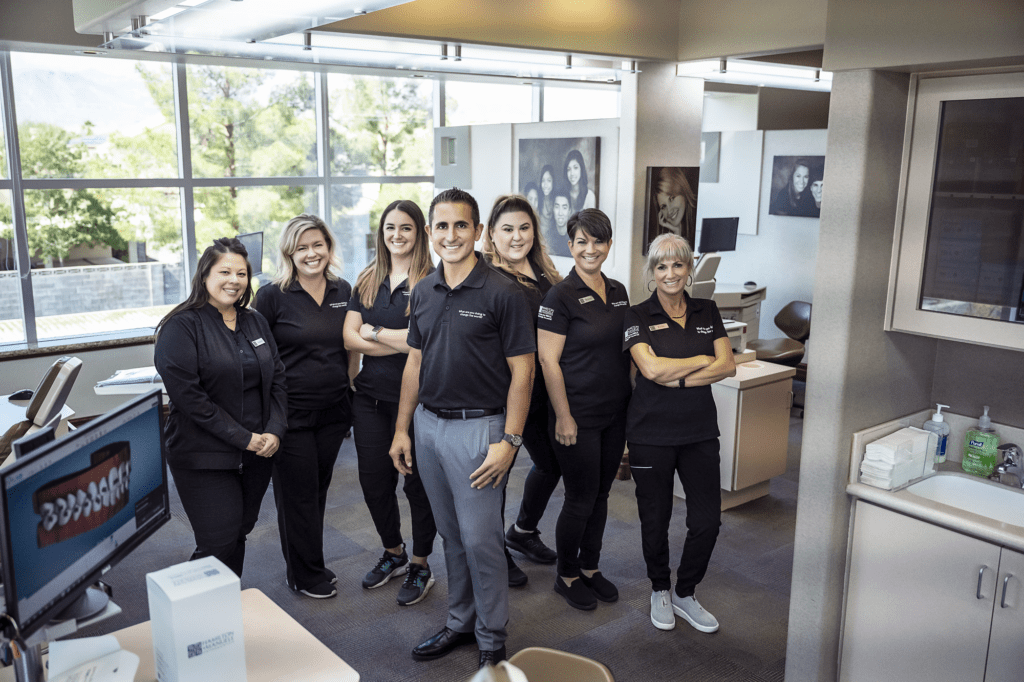
The transition to a partnership still had some growing pains. Manuele was coming into a workplace with an established workflow, and he had to learn how to communicate his expectations while considering how the team was perceiving them. As part of Cooper’s work as the partnership counselor, he sent surveys to the team to anonymously provide feedback.
Manuele had been eager to hit the ground running, bringing with him new technologies and new techniques to improve the practice. But some long-time team members were less enthused, which showed up in the surveys.
“My personality is to just go go go go, go go go. There were so many things that I was excited about bringing to the practice,” recalls Manuele. “Basically, I think I was stressing them out. Not intentionally but I didn’t understand their current workflow and workload. So, I would ask more of them than I should have because I didn’t realize all that they were already doing.”
After the surveys, he realized that his team wanted to do good work, but he needed to find a moderating balance so that they could continue to do so while also implementing the changes he wanted to see. Eventually, as new team members came in, they better understood the new dynamic of having two doctors in the practice, says Manuele.
In time, Manuele hired the practice’s first practice director, Danielle Terry. Her handling of team and patient management and participation in new hiring freed him up to do the thing he loves the most, treating patients.
One of Manuele’s primary roles since joining the practice has been to bring in new technology like 3D printing, managing aligner cases, and incorporating new software. Today the practice uses uLab’s aligners and treatment planning software for its aligner cases.
Prior to adopting uLab’s uSmile aligners, the practice printed aligners in-office for its simpler cases—a process that required Manuele to set up each case. Even with the promise of uSmile’s more efficient workflow for such cases, Manuele wasn’t initially swayed. He worried about the computer time needed to set up each case. And initially, setups did take him 30 to 40 minutes.
But that all changed when uLab released uDesign 7, its treatment planning software, which upgraded the guided setup. Like a lot of things in Manuele’s life, he dove headfirst into the software and what he discovered was that it was very good, and in his opinion, better than even uLab realized.
“Their software does a lot of cool things, but when they come up with it, they don’t even realize how it can be used until some doctor figures it out and says, ‘Hey, this is how you should use it’,” says Manuele.
The latest version of uDesign gives Manuele a workflow he’s been waiting for. Having used other aligner software in the past, he’d always been frustrated by the back and forth between the doctor and the aligner company’s lab on every case. Often during this exchange, a breakdown in communication would occur and result in changes Manuele didn’t request or failure to implement the changes he had requested.
With the latest version of uDesign, Manuele found he is able to make the changes he needs up front, before the case is even sent out, all while utilizing features like uAssist treatment planning assistance service to cut down case setup time.
For example, now when he uses uLab’s software, his team will do all the initial work before he takes over so that when he opens the case, it’s ready for teeth to be moved. He first jumps into the guided setup, sets the arch form, midlines, and vertical correction along with any other “big picture” adjustments he feels are necessary, and it takes him about 2 minutes.
Once that initial “pre-setup” is complete, all a tech must do is go through, correct the tips, torques, rotation, and adjust the IPR, and occlusion as needed. The things that were bogging him down when he was doing his own uDesign setups, are now done by someone else, says Manuele.
By the time he sees the case again, the attachments are on the teeth, the occlusion is dialed in to his liking, and the tips, torques, and rotations are about 90% correct, by his estimation, which he then can fine-tune.
The only other part of the setup he spends time on is staging. While some doctors use auto staging, Manuele enjoys the option of creating efficiencies with staging.
“Clinical efficiency is like sugar for me,” says Manuele. “I love to see if I can figure out a more efficient way to treat cases. So, if I can plan out a case and sequence it in a way where I can finish in 12 aligners instead of 20, that excites me, and the patients love finishing early.”
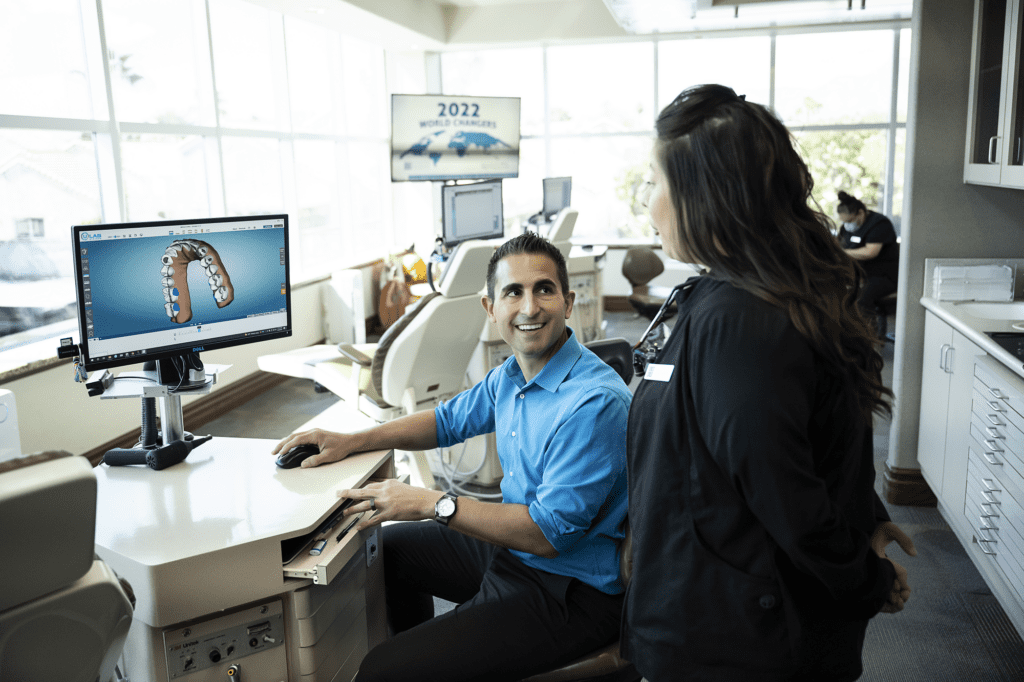
In recent months, Hamilton has allowed Manuele to take more responsibility in the practice. He officially became a partner in 2017 and they split clinical duties equally. But starting last year there was a tangible shift, with Hamilton spending fewer days in the office, first down to 10 days a month and now 8 days.
He told Manuele that he trusts him to run things the way he feels is best. For Manuele, the increased responsibility and freedom was energizing. Manuele would always tell people that the partnership was amazing, but while they were 90% simpatico on how to run the practice, there was always about 10% where he felt he might do things differently.
So once Hamilton handed him the reins, Manuele was able to start running with the things he thought would add to the practice.
“Dr Hamilton has literally been the best business partner that anybody could ask for,” says Manuele. “He just went over the top to make sure that this transition was as smooth as possible for his team members, for his family, and for my family.” OP



